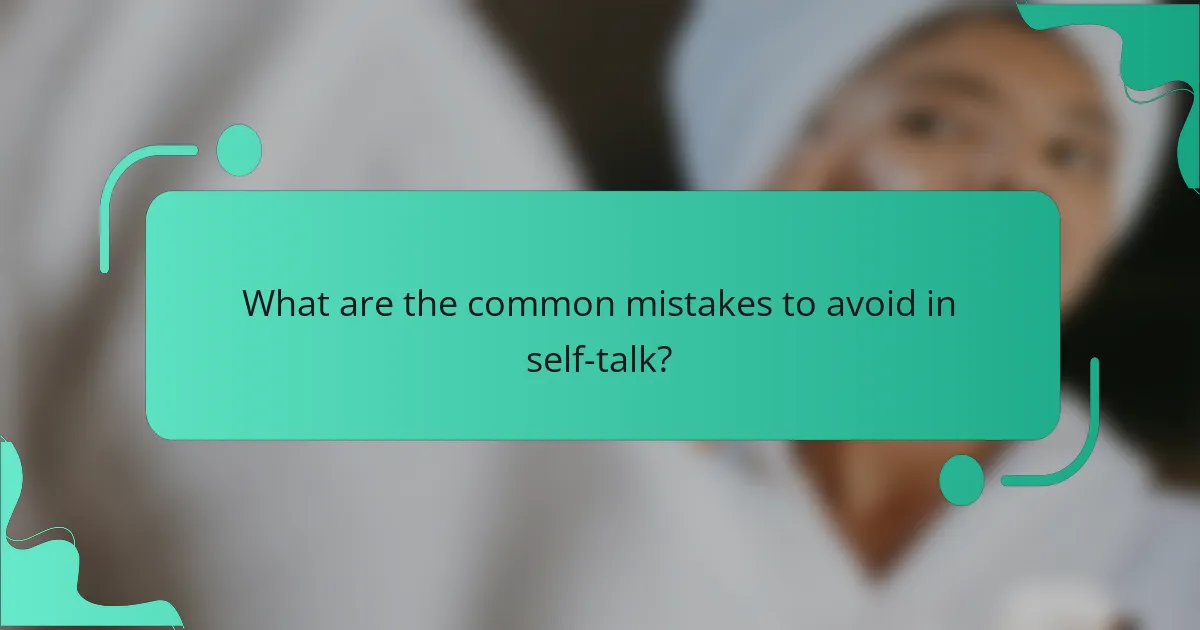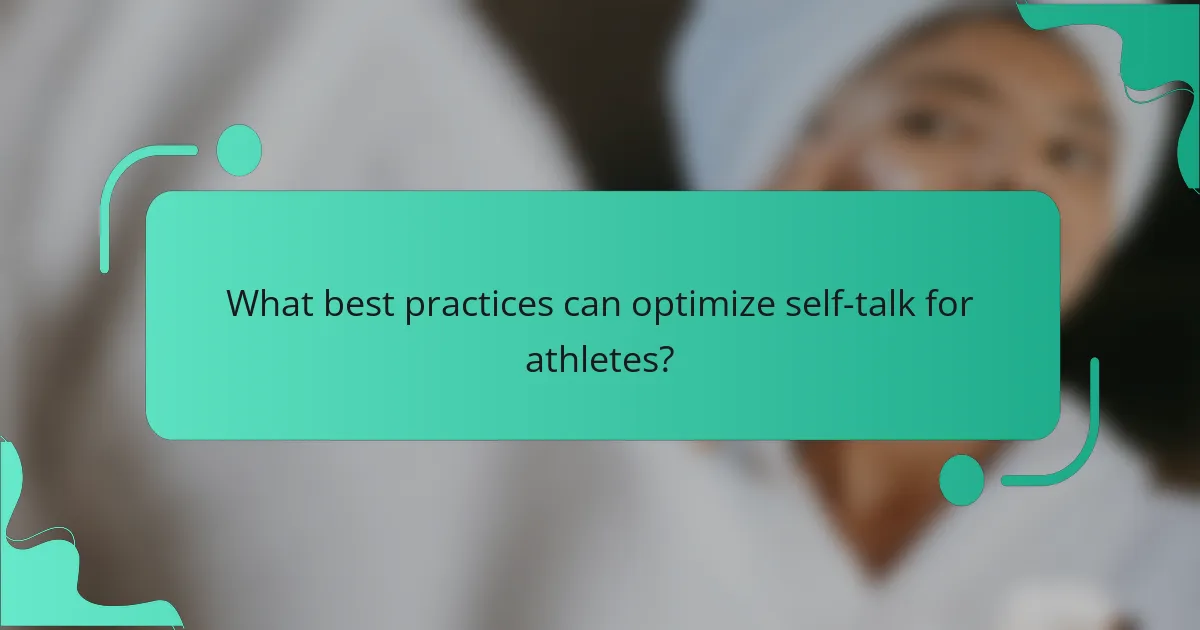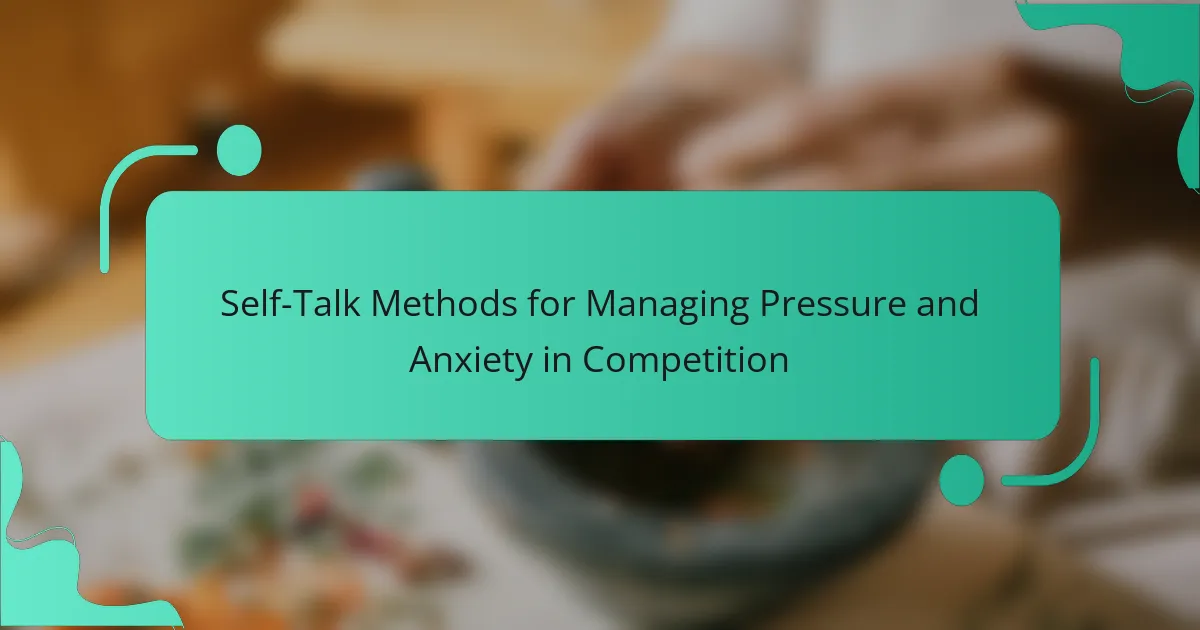Managing pressure and anxiety in competition is crucial for optimal performance. Self-talk methods, such as positive affirmations, visualization, and reframing negative thoughts, can effectively enhance focus and confidence. These techniques promote a constructive mindset, helping athletes view challenges as growth opportunities. Tailoring self-talk strategies to specific scenarios can further improve mental resilience and performance under pressure.

What are Self-Talk Methods for Managing Pressure and Anxiety in Competition?
Self-talk methods effectively manage pressure and anxiety in competition by promoting positive thinking and focus. Techniques include affirmations, visualization, and reframing negative thoughts.
Affirmations involve repeating positive statements to boost confidence. Visualization entails imagining successful performance scenarios, enhancing mental preparedness. Reframing helps athletes view challenges as opportunities for growth, reducing anxiety.
Research shows that athletes using positive self-talk experience lower anxiety levels and improved performance. This approach cultivates resilience, enabling better coping with competitive stress.
Incorporating these self-talk methods can lead to a more focused and confident mindset during competitions.
How does self-talk impact performance under pressure?
Self-talk significantly enhances performance under pressure by fostering confidence and reducing anxiety. Positive self-talk techniques, such as affirmations and motivational phrases, help athletes focus on their strengths and maintain composure. Research indicates that self-talk can improve reaction times and decision-making in high-stress situations. For instance, athletes who practice structured self-talk report higher levels of self-efficacy and better overall performance during competitions.
What are the psychological benefits of positive self-talk?
Positive self-talk enhances performance by reducing anxiety and boosting confidence. It promotes a constructive mindset, enabling athletes to focus on their strengths. Research shows that positive affirmations can lower stress hormones, leading to improved concentration and resilience. Additionally, consistent positive self-talk fosters a growth mindset, encouraging individuals to view challenges as opportunities for development. Ultimately, these psychological benefits create a supportive internal environment that aids in managing pressure effectively during competition.

What are the universal attributes of effective self-talk methods?
Effective self-talk methods share universal attributes that enhance performance under pressure. These methods are positive, specific, actionable, and timely. Positive self-talk fosters a constructive mindset, while specificity ensures clarity in goals. Actionable phrases guide immediate responses, and timely prompts align with critical moments in competition. Emphasizing these attributes can significantly reduce anxiety and improve focus.
What common techniques are used in self-talk for athletes?
Athletes commonly use techniques like positive affirmations, visualization, and reframing thoughts to manage pressure and anxiety. These methods enhance focus and confidence during competition.
Positive affirmations involve repeating encouraging phrases to boost self-belief. Visualization entails mentally rehearsing successful performances to create a sense of familiarity. Reframing helps athletes shift negative thoughts into constructive perspectives, promoting resilience.
Incorporating these techniques can significantly improve an athlete’s mental state, ultimately enhancing performance under pressure.
How can self-talk be structured for maximum effectiveness?
Self-talk can be structured effectively by focusing on positive affirmations, specific goals, and visualization techniques. Incorporating these elements enhances mental resilience during competition.
1. **Positive Affirmations**: Use encouraging phrases to boost confidence and reduce anxiety. For example, repeating “I am prepared” reinforces a strong mindset.
2. **Specific Goals**: Define clear, achievable objectives to maintain focus. This helps in managing pressure by breaking down performance into manageable tasks.
3. **Visualization Techniques**: Imagine successful outcomes and ideal performance scenarios. This prepares the mind for actual competition, reducing anxiety and enhancing focus.
4. **Consistent Practice**: Regularly practicing self-talk techniques builds familiarity and effectiveness. Consistency in application leads to better results in high-pressure situations.

What unique attributes differentiate self-talk methods in various sports?
Self-talk methods vary across sports due to unique attributes like specific language, timing, and focus. For instance, athletes in individual sports may use more personalized affirmations, while team sports often emphasize collective motivation. Unique attributes include sport-specific jargon and the role of coach influence in shaping self-talk strategies. Additionally, rare attributes, such as the use of visualization alongside self-talk, can enhance performance in high-pressure situations.
How do individual sports adapt self-talk strategies differently?
Individual sports adapt self-talk strategies to manage pressure and anxiety through tailored approaches. Athletes in sports like tennis focus on positive affirmations to boost confidence during critical points. In contrast, track athletes often use rhythmic self-talk to maintain pace and focus on breathing. Unique attributes of these strategies include individualization based on the sport’s demands, such as the need for concentration in golf versus the need for motivation in running. Each sport’s context influences the effectiveness of specific self-talk methods, allowing athletes to optimize their mental resilience in competition.
What role does team dynamics play in self-talk effectiveness?
Team dynamics significantly enhance self-talk effectiveness by fostering a supportive environment. Positive interactions within a team can boost individual confidence, making self-talk more constructive. For example, teammates can reinforce affirmations, helping to reduce anxiety during competition. Additionally, shared experiences and collective motivation can create a unique attribute of camaraderie, which enhances overall performance. In contrast, negative team dynamics may lead to self-doubt, diminishing the benefits of self-talk. Thus, a cohesive team structure is crucial for maximizing self-talk strategies in high-pressure situations.

What rare attributes can enhance self-talk effectiveness?
Rare attributes that can enhance self-talk effectiveness include personalization, emotional resonance, and contextual adaptability. Personalization tailors self-talk to individual experiences, making it more relatable. Emotional resonance connects self-talk with feelings, fostering motivation. Contextual adaptability adjusts self-talk strategies based on specific competitive situations, enhancing relevance and impact.
What uncommon self-talk phrases have shown success in high-pressure scenarios?
Uncommon self-talk phrases that have shown success in high-pressure scenarios include “This is a chance to grow,” “I thrive under pressure,” and “Focus on the next step.” These phrases help shift mindset, enhance resilience, and promote clarity. Using unique affirmations can transform anxiety into motivation, leading to improved performance.
How can cultural differences influence self-talk practices?
Cultural differences can significantly shape self-talk practices in competitive environments. Variations in cultural backgrounds influence the language, tone, and content of self-talk, impacting how individuals manage pressure and anxiety.
For instance, collectivist cultures may emphasize group cohesion in self-talk, promoting encouragement from peers. In contrast, individualistic cultures might focus on personal achievement, leading to more self-referential affirmations.
Moreover, cultural norms dictate acceptable expressions of emotion, which can affect the intensity and style of self-talk. Individuals from cultures that value stoicism may adopt more subdued self-talk, while those from expressive cultures might engage in more vocal and animated self-encouragement.
Understanding these cultural nuances can enhance the effectiveness of self-talk methods, allowing athletes to tailor their approaches to align with their cultural contexts.

How can self-talk be tailored to specific competition scenarios?
Self-talk can be tailored to specific competition scenarios by focusing on situational cues and desired outcomes. For high-pressure situations, use affirmations and calming phrases to reduce anxiety. In contrast, during routine competitions, motivational self-talk can enhance confidence. Tailoring phrases to the unique attributes of each scenario, such as the level of competition or personal stakes, optimizes effectiveness. Practicing these tailored self-talk strategies can lead to improved performance and mental resilience in athletes.
What are the best self-talk strategies for pre-competition anxiety?
Positive self-talk, visualization, and reframing thoughts are effective strategies for managing pre-competition anxiety. These methods help athletes focus on their strengths and foster a positive mindset.
Positive self-talk involves using affirmations and encouraging phrases to boost confidence and reduce negative thoughts. Visualization allows athletes to mentally rehearse their performance, creating a sense of familiarity and control. Reframing thoughts helps shift focus from fear of failure to opportunities for growth.
Incorporating these self-talk strategies can lead to improved performance and reduced anxiety levels. Practicing these techniques consistently can enhance mental resilience and readiness for competition.
How can self-talk be adapted during competitions?
Self-talk can be adapted during competitions by focusing on positive affirmations and visualization techniques. Athletes should replace negative thoughts with constructive phrases that reinforce confidence. For example, instead of thinking “I might fail,” change it to “I am prepared and capable.” Visualization involves mentally rehearsing successful performances, which can enhance focus and reduce anxiety. Incorporating these methods can help maintain composure and improve overall performance.

What are the common mistakes to avoid in self-talk?
Common mistakes in self-talk include using negative language, focusing on failures instead of successes, and making unrealistic comparisons. These errors can heighten pressure and anxiety during competition. To manage these effectively, practice positive affirmations, celebrate small achievements, and maintain a realistic perspective. Avoiding these pitfalls fosters a healthier mindset and enhances performance.
How can negative self-talk be identified and transformed?
Negative self-talk can be identified by recognizing patterns of self-criticism and doubt. Transforming it involves replacing these thoughts with positive affirmations and realistic self-assessments.
Awareness is crucial; keep a journal to track negative thoughts during competition. Challenge these thoughts by questioning their validity. Replace them with constructive alternatives that focus on strengths and past successes.
Practicing mindfulness can help in managing anxiety, as it encourages staying present. Techniques such as visualization and positive self-talk can reinforce a confident mindset.
Engaging in regular self-reflection allows for ongoing improvement in self-talk methods. This process enhances resilience and prepares individuals to handle pressure effectively.

What best practices can optimize self-talk for athletes?
Athletes can optimize self-talk by using positive affirmations, visualization techniques, and focusing on process-oriented thoughts. These methods help manage pressure and anxiety effectively.
1. Positive affirmations reinforce confidence. Athletes should repeat phrases like “I am prepared” to boost self-belief.
2. Visualization involves imagining successful performance scenarios. This mental rehearsal can enhance focus and reduce anxiety.
3. Process-oriented thoughts shift attention from outcomes to actions, promoting a sense of control during competition.
Incorporating these strategies can significantly improve an athlete’s mental resilience and performance under pressure.
How can athletes create a personalized self-talk plan?
Athletes can create a personalized self-talk plan by identifying specific situations that trigger pressure and anxiety. They should develop tailored phrases that reinforce confidence and focus. Regular practice of these phrases in training can enhance effectiveness during competition. Additionally, athletes should evaluate and adjust their self-talk strategies based on performance outcomes to ensure continuous improvement.
What role do coaches play in developing effective self-talk methods?
Coaches play a crucial role in developing effective self-talk methods by teaching athletes to reframe negative thoughts. They provide strategies to cultivate positive internal dialogue, enhancing performance under pressure. Coaches often use techniques like visualization and affirmations to help athletes manage anxiety, fostering a growth mindset. By creating a supportive environment, coaches encourage athletes to practice self-talk consistently, leading to improved focus and resilience during competition.
